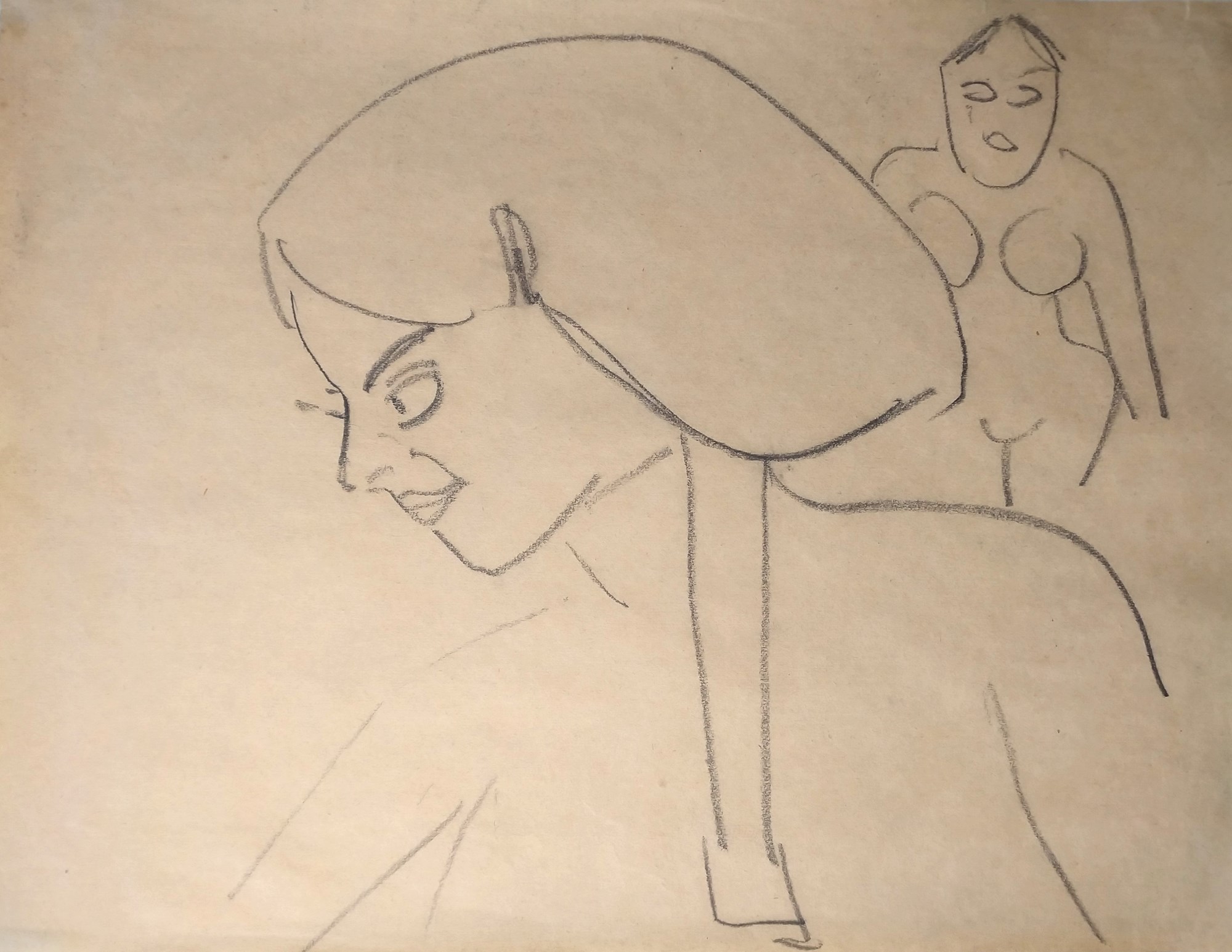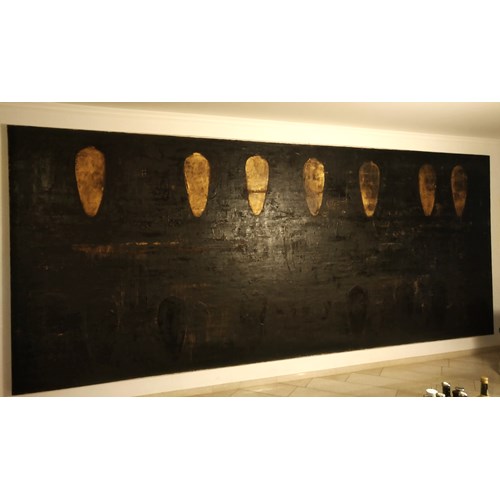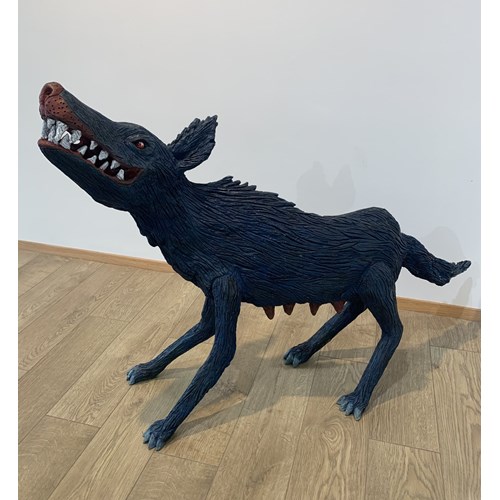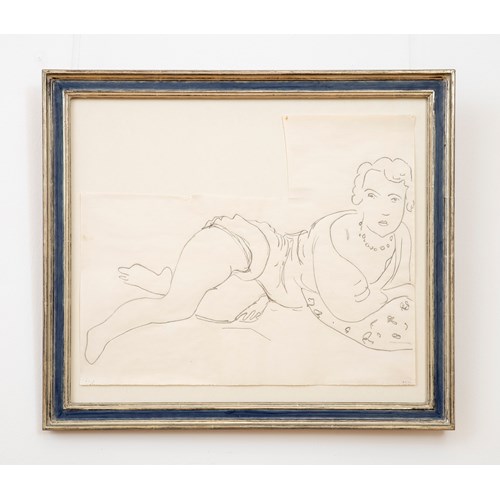Ernst Ludwig Kirchner
Mädchenkopf - Fränzi (Head of a Girl - Fränzi)
Date 1910
Period 20th century
Origin Dresden, Germany
Medium Pencil on brownish paper
Dimension 33.2 x 42.8 cm (13¹/₈ x 16⁷/₈ inches)
The portrait also displays the influence of the primitive art from Dresden’s ethnographic museum, which opened to the public in March 1910. Kirchner himself wrote in retrospect that “in this museum I found the carved beams of the natives of the Palau islands, whose figures showed exactly the same formal language as mine.” Also closely linked to tribal art is the decoration of Kirchner’s studio, which provides the background to the portrait. The mural, painted by the artist and featuring highly schematised female nudes against a deep green background, is often found in works of his. It can also be glimpsed in a photograph Kirchner took of Fränzi and a boy in his Dresden studio, in which the girl is sprawled on some cushions strewn over the floor and has a fairly provocative gaze.
Lina Franziska "Fränzi" Fehrmann, (* October 11, 1900 in Dresden; † June 10, 1950 in Dresden), was the most important child model and muse of the "Brücke" artists Ernst Ludwig Kirchner, Erich Heckel and Max Pechstein.
She was introduced to the group of artists in 1909, at the age of eight, and was depicted in numerous works by the painters until 1911. Unlike professional models, Fehrmann was often portrayed in motion and is associated with a new, faster style of painting in oil in the work of the "Brücke" artists. For a long time only known by her first name Fränzi, which appears in the titles of paintings, Fehrmann's identity was revealed in 1995 through entries in Kirchner's sketchbook.
From 1905, the Brücke artists increasingly turned to nude drawings, an aspect that became central to the artists' work during their time in Dresden. They regarded the (naked) human being as the basis of art in general. "That's why you have to start with people themselves," said Kirchner. For a precise study of the human being, in turn, the nude had to be studied "in free naturalness". The aim was not to copy nature, but to depict "the type of naked human being of our time in numerous nude paintings".
In the tradition of Munch's “Pubertät”, which had caused a scandal in 1894, from 1905 the Brücke artists not only studied the female nude in the adult stage, but were also interested in its preliminary stages and development, i.e. also the pubertal and prepubertal stages of women. In doing so, they followed a redefinition of the concept of the nude that was emerging at the time: "After the female nude had shaped the awakening woman for a long time, studies of becoming [attracted] attention at the turn of the 20th century. Psychoanalytical research confronted man with his body, his drives, with what unconsciously and inexorably emerged. As a result, people dared to depict the naked girl, in whom the woman slumbered, on canvas and paper." Among other things, the "inner movement" of the models was of interest: "The development from child to woman progresses at every moment. No other stage of life is so characterized by dramatic change. Nothing is complete. Everything oscillates. There is never a moment when something is not changing. Painters like Kirchner and his friends sensed this and pursued it artistically."
Alongside Marcella and Schwesterpaaren, who covered the pubertal phase in Brücke's work, Fränzi stood for the prepubertal phase in the Brücke artists' oeuvre. She is understood as a "child" and is regularly referred to as a child in the titles of drawings and paintings by the Brücke artists (Heckel: Child (1909), Heckel: Child with Shell Necklace (1909), shell necklace also on Kirchner's Fränzi in front of a carved chair). In Kirchner's sketch paintings, Fränzi, like other female models, appears as a type. However, there is little interest in a realistic portrayal of Fränzi: Kirchner "searches for a formulation of the female nude as it appears in the 'Child'." At the same time, "after the child models such as Fränzi Fehrmann, [Kirchner's] works already herald an erotic, but nevertheless rather sexless image of women. Their still undeveloped bodies, and thus their androgyny, fascinated the artist". By mid-1910, he had already internalized the "Fränzi type" to such an extent that he was able to sketch depictions of Fränzi without the model being present.
Lina Franziska Fehrmann and Peter in a photograph by Ernst Ludwig Kirchner in 1910; Heckel repeated the motif in his painting Children (on the bench) from 1910
Drawings often show Fränzi in motion, on roller skates in the studio, making candles and rolling, playing with a cat, swinging or dancing. With Fränzi, the Brücke artists' representation expanded away from the static nude: through Fränzi, Kirchner was able to continue the "study of movement, which has accompanied my entire work to this day and from which I received my own formal language", which he had already found in 1901 and which he perceived as "something completely new".
The search for new ways of painting was also connected with and conditioned by this. Although fast movements and thus a quicker depiction could be processed in sketches, drawings and watercolors, as Kirchner's sketchbooks clearly show, the Brücke painters, above all Kirchner and Heckel, were now also looking for an adequate realization in oil. Looking back in 1935, Kirchner noted that he had to change his style of oil painting with impasto brushwork and find a "new technique ... to paint with little color and a lot of liquid and invent his own ground that absorbed and dried easily.
In his 1958 memoirs, Fehrmann also cited Heckel as a trigger for the Brücke artists' new painting style, stating that Fränzi was "a special event from 1909 and is connected with the formulation of relatively flat painting that began at the end of 1908. They are pictures painted with diluted paint, I would like to put it that way. Although this method of painting had been tried out before, it did not actually begin until the end of 1908. In 1909, this method of painting became the "general rule" for us. At this time, paintings such as Artistin (Marzella) or Fränzi in front of a carved chair were created, which, in contrast to earlier works, show simplified forms and a flat application of paint. They are clearly influenced by artists such as Henri Matisse and Edvard Munch.
Exotic element:
Around 1910, the Brücke artists, and Ernst Ludwig Kirchner in particular, became increasingly interested in non-European art. The Ethnological Museum in Dresden was reopened in March 1910. Kirchner was particularly fascinated by the bas-reliefs of the Dresden "Palau-Balkens". His works from 1910 are dominated by hard contours and two-dimensional depictions. From 1910, Erich Heckel turned to woodcuts and his works, like those of Kirchner, show an increasing reduction or tightening of form as well as angular contours. "Fränzi's boyish figure favoured a working method that went into the surface and the development of angular contours, unlike adult female models, who tended towards sculptural modelling and flowing forms." Her eyes were often narrowed and her long black hair was shown loose, emphasizing the exotic aspect of her figure.
In the life of the indigenous peoples, the Brücke artists wanted not least to "create parallels to their life and work in the studios and above all at the Moritzburg ponds. They also formed a community there with their young models and girlfriends, moved freely and unclothed in the residential studios or enjoyed themselves and sunbathed in the great outdoors."[43] Around 1910, the ideal of the Brücke artists became the existence of the free and "innocent" human being in pristine nature. "The 'nature child' Fränzi embodies an ideal image of the Brücke utopia of freedom and originality - an amalgam of eroticism and exoticism."
"On the remote north-eastern shore of the Dippelsdorf pond, the triumvirate achieved the greatest mutual closeness in artistic expression in the legendary summer of 1910 with 'fanatical free work' on free people in the great outdoors. The heroine of the pictures, which look like snapshots, is the childlike favourite model Fränzi ... In Moritzburg, the BRÜCKE succeeds in the happy realization of a utopia with the original combination of anti-bourgeois lifestyle and radical visual language, social experiment and art revolution - for a short time."
Date: 1910
Period: 20th century
Origin: Dresden, Germany
Medium: Pencil on brownish paper
Signature:
Rückseitig mit dem Nachlassstempel und der Bezeichnung "B Dre/Ab 23" (Ab durchgestrichen und mit Ba ersetzt), sowie den Nummerierungen "K 2836", "C 5678" und "2460" in Tusche und Bleistift. With the Estate-Stamp and the numberings "B Dre/Ab 23" (Ab crossed and replaced with "Ba"), "K 2836", "C 5678" and "2460" in ink and pencil.
Dimension: 33.2 x 42.8 cm (13¹/₈ x 16⁷/₈ inches)
Provenance:
Collection Ernst Ludwig Kirchner, Dresden, Berlin, Davos (until 1938). Collection Erna Kirchner / Estate Ernst Ludwig Kircher, Davos, Switzerland (until 1945); Kirchner Estate as depositum in Kunstmuseum Basel, Switzerland (1946 – 1954); Kirchner Estate / Stuttgarter Kunstkabinett Roman Norbert Ketterer, Stuttgart Germany and Campione d’Italia, Italy (1954-2001); Kirchner Estate Family of Roman Norbert Ketterer (2001 – 2017) Private collection Marc Triebold, Olsberg, Switzerland (June 2017 – 2023).
Literature:
Not published
Exhibition:
GMT Galerie Marc Triebold, Riehen, Switzerland, November 2023.
More artworks from the Gallery









